3.7.4 RTA-Experiments




Next: 4 Oxidation
Up: 3.7 Applications
Previous: 3.7.3 Field Oxide Isolation
In this section we verify our model RTA (Section 3.2.4)
by simulating boron diffusion for temperatures ranging from  to
to  for diffusion times
for diffusion times  and
and  [Sol92].
With the large number of parameters it is possible to perfectly fit
virtually any single profile, but the parameter set is not unambiguous. We
tried to find a consistent set of parameters for various profiles which
still achieves good agreement between simulation and experimental results.
[Sol92].
With the large number of parameters it is possible to perfectly fit
virtually any single profile, but the parameter set is not unambiguous. We
tried to find a consistent set of parameters for various profiles which
still achieves good agreement between simulation and experimental results.
For the first three experiments boron was implanted at an energy of
 with a dose of
with a dose of  through
a
through
a  Å screening oxide. The boron concentrations are below the
solubility limit, such that cluster effects are negligible (cluster effects
are disregarded by the model).
Å screening oxide. The boron concentrations are below the
solubility limit, such that cluster effects are negligible (cluster effects
are disregarded by the model).
As initial conditions for the diffusion simulation we used the measured
implantation profile  for boron (
for boron ( ,
,  ,
,
 ) and calculated damage profiles for the
interstitials. We calculated the initial damage profiles with
PROMIS' analytic implant model DAMPAR (see
Section 2.4) and corrected the local interstitial
concentration by a factor of 1/8 [Hob89], [Pic91]
(cf. page
) and calculated damage profiles for the
interstitials. We calculated the initial damage profiles with
PROMIS' analytic implant model DAMPAR (see
Section 2.4) and corrected the local interstitial
concentration by a factor of 1/8 [Hob89], [Pic91]
(cf. page  ).
).
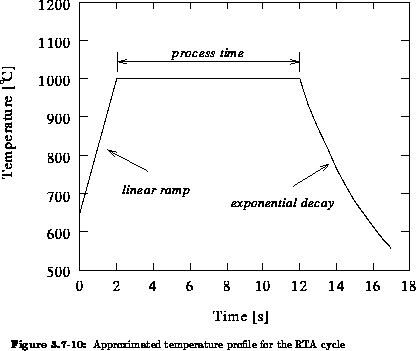
To resemble the temperature profile observed during rapid thermal annealing,
we split the RTA cycle into three phases (see Figure 3.7-10). In
the first phase the temperature rises with a rate of  ,
which is suitable for RTA equipment, until it reaches the process
temperature. After the second phase of constant temperature, the temperature
decays exponentially with a time constant of
,
which is suitable for RTA equipment, until it reaches the process
temperature. After the second phase of constant temperature, the temperature
decays exponentially with a time constant of  to room temperature in
the third phase.
to room temperature in
the third phase.
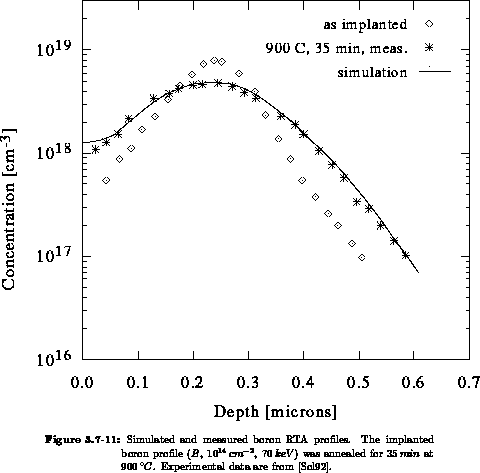
Figures 3.7-11 to 3.7-13 show the simulated and
measured boron profiles. The implanted boron profile ( ,
,
 ,
,  ) was annealed in inert ambient
for
) was annealed in inert ambient
for  at
at  ,
,  and
and
 , respectively. There is good agreement between simulation
and experimental results for all three temperatures. This conformity
verifies the model's temperature dependence of the transient diffusion
enhancement, i.e. the activation energy of the reaction velocity
, respectively. There is good agreement between simulation
and experimental results for all three temperatures. This conformity
verifies the model's temperature dependence of the transient diffusion
enhancement, i.e. the activation energy of the reaction velocity  .
However, for the verification of our consistent parameter set we need
to simulate profiles at one temperature for different diffusion times.
.
However, for the verification of our consistent parameter set we need
to simulate profiles at one temperature for different diffusion times.
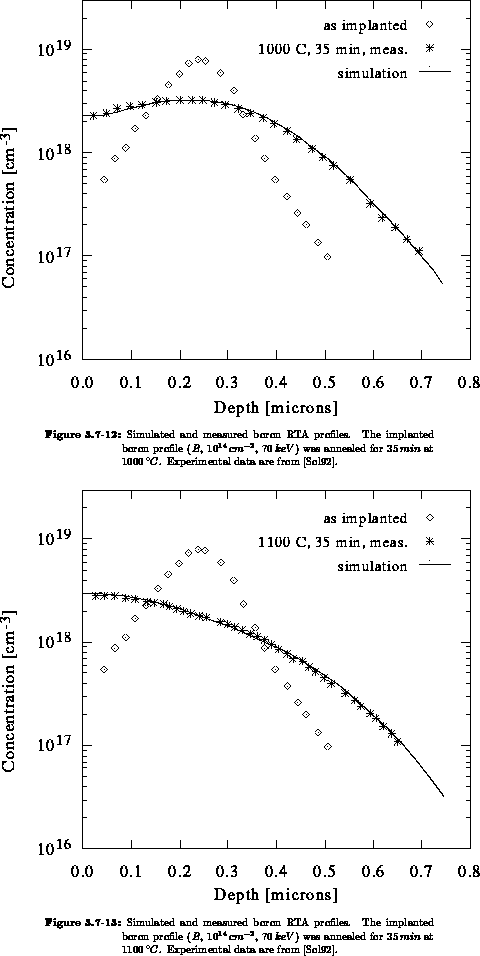
In the fourth experiment boron was implanted with an energy of
 with a dose of
with a dose of  through a
through a
 Å screening oxide. Again, the boron peak concentration is
well below the solubility limit, such that cluster effects are negligible.
An RTA cycle was performed for a process time of
Å screening oxide. Again, the boron peak concentration is
well below the solubility limit, such that cluster effects are negligible.
An RTA cycle was performed for a process time of  at
at
 . For these conditions, normal diffusion models report a
motion of boron of only about
. For these conditions, normal diffusion models report a
motion of boron of only about  - in the experiment we
observe a displacement of
- in the experiment we
observe a displacement of  . This anomalous transient
displacement is reproduced quite acceptably by our simulations
(Figure 3.7-14). The transient enhanced diffusion is predicted
quantitatively correct by the model also for short time anneal.
Nevertheless, only with a more complete set of experiments the parameters
can be proven.
. This anomalous transient
displacement is reproduced quite acceptably by our simulations
(Figure 3.7-14). The transient enhanced diffusion is predicted
quantitatively correct by the model also for short time anneal.
Nevertheless, only with a more complete set of experiments the parameters
can be proven.
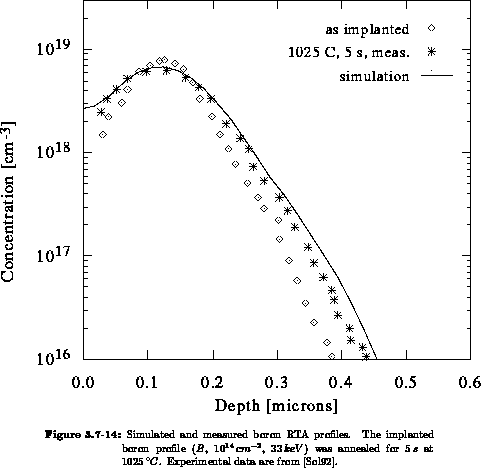
During the extraction of the parameters with PROFILE [Ouw89]
we observed the following influences of the different parameters. The most
critical model parameter is the reaction velocity  . It determines the
time dependence of the transient enhancement effect. Discrepancies in the
equilibrium ratio
. It determines the
time dependence of the transient enhancement effect. Discrepancies in the
equilibrium ratio  may be partially compensated by the
reaction coefficients
may be partially compensated by the
reaction coefficients  and
and  . The model is fairly
insensitive with respect to the precise values of the Frenkel-pair
constant
. The model is fairly
insensitive with respect to the precise values of the Frenkel-pair
constant  and the surface self-interstitial annihilation
rate
and the surface self-interstitial annihilation
rate  .
.
Physically, the transient enhanced diffusion is attributed to two facts, a
high interstitial component of implanted boron and an enhanced point defect
concentration related to the implantation damage. We noticed that the
initial substitutional component of boron, i.e.  in the initial
condition (3.2-70), has only minor influence on the final
distribution. No changes in the final profiles can be recognized, as long as
the initial substitutional component does not exceed
in the initial
condition (3.2-70), has only minor influence on the final
distribution. No changes in the final profiles can be recognized, as long as
the initial substitutional component does not exceed  (
( ) of the total boron concentration .
Figure 3.7-15 shows the peak concentrations of substitutional
boron for different
) of the total boron concentration .
Figure 3.7-15 shows the peak concentrations of substitutional
boron for different  .
.
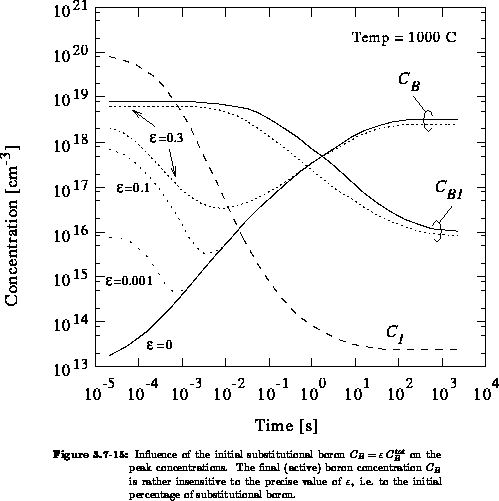
The given pair diffusion model has been successfully verified against
experimental data. The model is able to predict the transient enhanced
diffusion effect during low thermal budget processes quantitatively correct.
The model does not include any high concentration effects (clustering). It
neglects reactions according the Frank-Turnbull mechanism ( and
and  ), which
might not be valid in the early stage of the diffusion. For the calculation
of the electric field the model disregards the charges caused by
point defects and dopant point-defect pairs, which is only justified as long
as dopants are primarily at substitutional sites. Anyhow, the electric field
is not that important for the transient enhanced diffusion effect
(particularly at the relatively low concentrations considered in our
examples).
), which
might not be valid in the early stage of the diffusion. For the calculation
of the electric field the model disregards the charges caused by
point defects and dopant point-defect pairs, which is only justified as long
as dopants are primarily at substitutional sites. Anyhow, the electric field
is not that important for the transient enhanced diffusion effect
(particularly at the relatively low concentrations considered in our
examples).




Next: 4 Oxidation
Up: 3.7 Applications
Previous: 3.7.3 Field Oxide Isolation
Martin Stiftinger
Wed Oct 19 13:03:34 MET 1994
 to
to  for diffusion times
for diffusion times  and
and  [Sol92].
With the large number of parameters it is possible to perfectly fit
virtually any single profile, but the parameter set is not unambiguous. We
tried to find a consistent set of parameters for various profiles which
still achieves good agreement between simulation and experimental results.
[Sol92].
With the large number of parameters it is possible to perfectly fit
virtually any single profile, but the parameter set is not unambiguous. We
tried to find a consistent set of parameters for various profiles which
still achieves good agreement between simulation and experimental results.




 with a dose of
with a dose of  through
a
through
a  Å screening oxide. The boron concentrations are below the
solubility limit, such that cluster effects are negligible (cluster effects
are disregarded by the model).
Å screening oxide. The boron concentrations are below the
solubility limit, such that cluster effects are negligible (cluster effects
are disregarded by the model).
 for boron (
for boron ( ,
,  ,
,
 ) and calculated damage profiles for the
interstitials. We calculated the initial damage profiles with
PROMIS' analytic implant model DAMPAR (see
Section
) and calculated damage profiles for the
interstitials. We calculated the initial damage profiles with
PROMIS' analytic implant model DAMPAR (see
Section 

 ,
which is suitable for RTA equipment, until it reaches the process
temperature. After the second phase of constant temperature, the temperature
decays exponentially with a time constant of
,
which is suitable for RTA equipment, until it reaches the process
temperature. After the second phase of constant temperature, the temperature
decays exponentially with a time constant of 
 ,
,
 and
and
 .
However, for the verification of our consistent parameter set we need
to simulate profiles at one temperature for different diffusion times.
.
However, for the verification of our consistent parameter set we need
to simulate profiles at one temperature for different diffusion times.

 with a dose of
with a dose of  . For these conditions, normal diffusion models report a
motion of boron of only about
. For these conditions, normal diffusion models report a
motion of boron of only about  - in the experiment we
observe a displacement of
- in the experiment we
observe a displacement of  . This anomalous transient
displacement is reproduced quite acceptably by our simulations
(Figure
. This anomalous transient
displacement is reproduced quite acceptably by our simulations
(Figure 
 may be partially compensated by the
reaction coefficients
may be partially compensated by the
reaction coefficients  and
and  . The model is fairly
insensitive with respect to the precise values of the Frenkel-pair
constant
. The model is fairly
insensitive with respect to the precise values of the Frenkel-pair
constant  and the surface self-interstitial annihilation
rate
and the surface self-interstitial annihilation
rate  .
.
 in the initial
condition (
in the initial
condition ( (
( ) of the total boron concentration
) of the total boron concentration
 and
and  ), which
might not be valid in the early stage of the diffusion. For the calculation
of the electric field the model disregards the charges caused by
point defects and dopant point-defect pairs, which is only justified as long
as dopants are primarily at substitutional sites. Anyhow, the electric field
is not that important for the transient enhanced diffusion effect
(particularly at the relatively low concentrations considered in our
examples).
), which
might not be valid in the early stage of the diffusion. For the calculation
of the electric field the model disregards the charges caused by
point defects and dopant point-defect pairs, which is only justified as long
as dopants are primarily at substitutional sites. Anyhow, the electric field
is not that important for the transient enhanced diffusion effect
(particularly at the relatively low concentrations considered in our
examples).